Fundulopanchax gardneri
Steel-blue Killifish
SynonymsTop ↑
Fundulus gardneri Boulenger, 1911; Haplochilus brucii Boulenger, 1911; Aphyosemion gardneri (Boulenger, 1911); Aphyosemion nigerianum (Clausen, 1963); Aphyosemion gardneri vanderveldei Radda, 1974; Aphyosemion gardneri lacustre Langton (ex Radda), 1974; Aphyosemion gardneri mamfense Radda, 1974; Aphyosemion gardneri obuduense Wright and Jeremy, 1974; Aphyosemion gardneri clauseni Scheel, 1975; Aphyosemion (Paraphysemion) biafranum Kottelat, 1976; Aphyosemion nigerianum meridionale Kottelat, 1976
Etymology
Fundulopanchax: originally named as a subgenus by Myers (1924) due to members appearing to represent an evolutionary link between the genera Fundulus and Panchax as they were understood at the time.
gardneri: named for ‘Mr. R. D. Gard’ner’, who collected the type specimens.
Classification
Order: Cyprinodontiformes Family: Nothobranchiidae
Distribution
Native to the Cross River system in southeastern Nigeria and western Cameroon plus the Benue River drainage in central Nigeria.
Known populations include Akaram, Akure, Enugu, Kluge, Lafia, Makurdi, Nsukka, Okwoga and Udi Mountain.
The type series consists of three specimens collected from ‘head-waters of Cross River, Calabar…Okwoga 7°N, 7°45’E’ which corresponds to the town Okwoga in Benue state, mideastern Nigeria.
Of the nominal subspecies (see ‘Notes’), F. g. lacustris is known only from Lake Ejagham and its tributary stream in western Cameroon, F. g. mamfensis occurs in rainforest tributaries of the upper Cross River in the Mamfe lowlands of southwestern Cameroon and F. g. nigerianus is distributed throughout southern, southwestern, central, northern and eastern Nigeria including the Niger and Benue rivers plus minor coastal drainages of southeastern Nigeria, and in the Benue system it’s also been recorded in western Cameroon.
Collections of wild fish are generally labelled with some form of code in order that they can be told apart, thus limiting the possibility of hybridisation.
Habitat
Most forms inhabit creeks, swamps, streams and pools in humid, forested, highland savannah and areas of rainforest.
Some such habitats periodically dry out but in many cases this is not a regular, annual event and they may retain water year-round.
Maximum Standard Length
50 – 55 mm.
Maintenance
The set-up need not be too complicated but be sure to cover the aquarium well since this species is a prodigious jumper.
Provide plenty of cover in the form of aquatic plants, wool mops, etc., and if using filtration air-powered, sponge-type units are best as these will not harm eggs or fry.
Lighting is unimportant but can be used if you wish, and growth of filamentous algae should not be discouraged.
Water Conditions
Temperature: 20 – 26 °C
pH: 6.0 – 7.5
Hardness: 18 – 179 ppm
Diet
Primarily a micropredator feeding on small aquatic crustaceans, worms, insect larvae and other zooplankton although algae and other plant material may also be taken.
In the aquarium dried foods are accepted in most cases but regular meals of small live or frozen fare such as Artemia, Daphnia orbloodworm should also be offered.
Behaviour and CompatibilityTop ↑
This is a robust killi that can be kept with other fishes but is not suitable for the general community.
Males can be aggressive towards one another but provided the aquarium contains sufficient refuges a group can normally be maintained together.
Ideally stock 2-3 females per male in order that no individual is singled out for excessive attention from the male(s).
Sexual Dimorphism
Males grow larger, are more brightly-coloured and develop more-extended fins than females.
Reproduction
The unpredictable nature of many of this species’ natural habitats have resulted in it evolving what’s often referred to as a ‘switch’ or ‘semi-annual’ breeding strategy whereby the eggs are able to withstand a period of drying but will also incubate and hatch when permanently submerged in water.
If conditions are suitable most forms are not difficult to breed with eggs deposited among live plants, aquatic mosses, synthetic mops, etc., while some breeders prefer to use a small tray of peat which is removed and dried post-spawning.
Eggs are best removed on a daily basis as the adults will eat any they find.
Under water they normally hatch within 14-21 days depending on temperature while 3-4 weeks tends to be the ‘standard’ period of drying.
The fry are free-swimming almost immediately and can be offered Artemia nauplii, microworm and similar as first foods.
NotesTop ↑
This species is also known as ‘Gardner’s Killi’ and ‘blue lyretail’ and the commonly-available aquarium forms are perhaps among the best choices for those new to keeping killifishes being relatively hardy, colourful and easy to breed.
A number of ornamental strains have also been line-bred by aquarists including ‘gold’ and albino.
Wild populations exist in numerous colour forms of which three, F. g. lacustris, F. g. mamfensis and F. g. nigerianus, have been described as nominal subspecies.
The latter is among the commoner forms encountered in the aquarium trade.
The genus Fundulopanchax has a somewhat confusing taxonomic history but as currently understood includes the former subgenera Paraphyosemion, Gularopanchax, and Paludopanchax while some authors have considered the species A. marmoratum, A. oeseri and A. scheeli members of the subgenus Pauciradius.
All of the above are included in Fundulopanchax here on SF at the moment.
References
- Boulenger, G. A., 1911 - Annals and Magazine of Natural History (Series 8) v. 8 (no. 44): 260-268
Descriptions of new African cyprinodont fishes. - Myers, G. S., 1924 - American Museum Novitates No. 116: 1-9
A new poeciliid fish from the Congo, with remarks on funduline genera. - Stiassny, M. L. J., G. G. Teugels and C. D. Hopkins (eds), 2007 - Publications scientifiques du Museum, MRAC. Vol. 2: 1-603
The fresh and brackish water fishes of Lower Guinea, West-Central Africa.
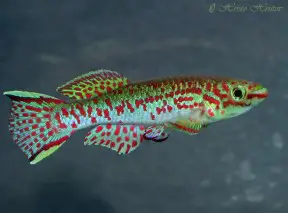

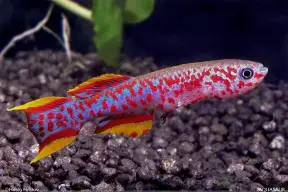
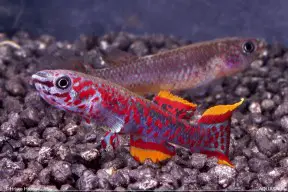
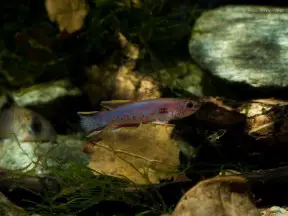
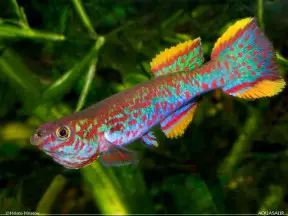
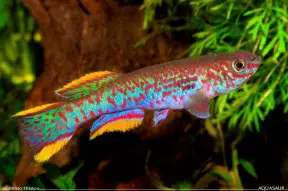
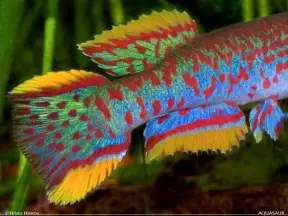
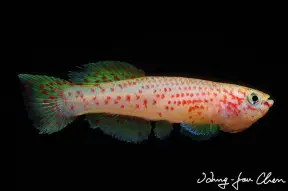
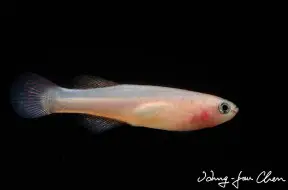
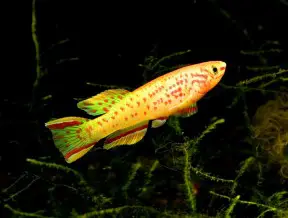
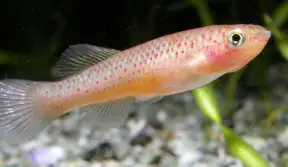
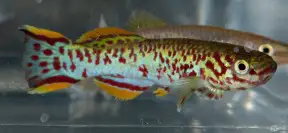
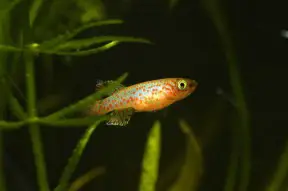



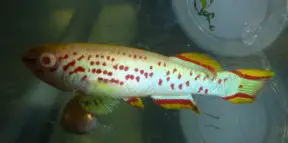

February 25th, 2013 at 5:53 am
maybe you can use this
http://www.micropress-inc.com/fishpic/albino-gardneri.jpg
http://www.micropress-inc.com/fishpic/albino-gardneri2.jpg
also
“Male F. g. gardneri are very aggressive towards one another and sufficient space must be provided if more than one is to be kept.’
if anything, “may be aggressive”. I have several gardneri tanks (different strains) with multiple males and never saw aggression…
February 25th, 2013 at 2:21 pm
I’ve done some basic editing and changed the photos. Better now?
Would be great to include the albino form – are the pics yours Mike?
February 25th, 2013 at 2:28 pm
Looks better and I see a load of nice photos now!
Albinos are mine, sure use them.
I was not able to track reliably which locale the strain originates from.
February 25th, 2013 at 2:41 pm
Ok great added those as well, thanks a lot Mike!
February 25th, 2013 at 2:48 pm
My pleasure…. but I don’t think you need quotes around ‘albino’.
If I can get decent shots of the other strains I have (Latia, Innidere) I’ll post them.